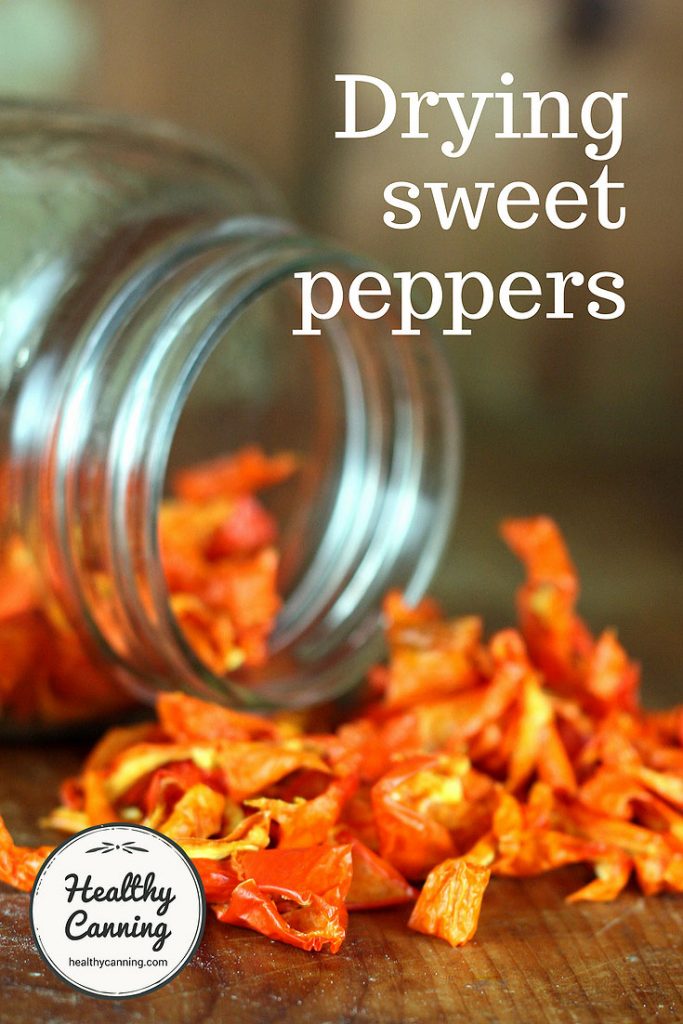Drying sweet peppers is easy and yields a high-quality product.
You use dried sweet peppers as a flavouring / seasoning element in dishes.
Dried green bell peppers have a mild zippy taste to them; dried red bell peppers have a sweeter taste.
See also: Canning peppers, Green pepper powder
Yields and Equivalents
½ bushel bell peppers = 5 kg (11 lbs) = 1 litre (quart) in volume cleaned, chopped, dried = approx 250 g (½ lb)
1 tablespoon dried chopped sweet pepper = 3 tablespoons fresh chopped sweet peppers
1 cup dried chopped sweet pepper = 70 g / 2 oz
1 bell pepper = ¼ cup dried bell pepper flakes (SETP, 2014, page 364)
Directions
Here we compare directions from three different sources.
Ball Blue Book
Preparation: Wash, remove stem and seeds, dice.
Blanching: None
Temperature: 125 F / 52 C
Time: Until leathery
Notes: “Choose any well-shaped bell pepper.”
Water content: 93%. (Used if doing a Dehydration Weight Test.)
Reference: Ball Blue Book, 37th edition, 2014. Page 167.
Note: Ball All New (2016) says “Cut into ¼ inch (.5 cm) wide strips.” (Page 340)
Excalibur
Preparation: Remove the stems, seeds and white sections, then wash and dry the peppers. Cut into ¼ ” strips or rings, or chop in a blender.” Presoak if desired.
Blanching: Pretreatment is not necessary, however, you can soak in 1 teaspoon sodium bisulfite per cup water.”
Temperature: 125 F / 52 C
Time: 4 to 8 hours until leathery.
Notes: “Select fresh well-formed peppers that have thick walls. Good drying peppers include California Wonder, Merimack Wonder, Oakview Wonder, and Big Bertha.”
Quality: Good
Reference: Excalibur. Preserve it naturally. 4th edition, 2012. Page 26 and 58.
So Easy To Preserve
Preparation: Wash, stem, core. Remove “partitions.” Cut into disks about ⅜ by ⅜ inch.” [Ed. We can’t quite picture that either. And presumably core involves getting all seeds out at the same time.]
Blanching: None
Temperature: 140 F / 60 C
Drying time: 8 to 12 hours
Quality: Good
Reference: So Easy To Preserve. 6th Edition. 2014. Page 350.
Storage
Let the dehydrated product cool completely to room temperature before packing it into storage containers.
Watch the sealed containers for the first few days for any sign of condensation. If condensation occurs, dehydrate a bit more.
Label jar with name of product and date. Store away from heat and direct light.
Usage notes
Use in soups, stews, casseroles, pasta sauces, rice dishes, etc.
Or, grind up and use as a spice.
To rehydrate:
Cover with cold water and soak 30 to 90 minutes, or cover with boiling water and soak 20 to 60 minutes. After soaking, simmer until tender.” [1]P. Kendall, P. DiPersio and J. Sofos. Drying Vegetables. Colorado State University Cooperative Extension. Publication no. 9.308. July 2004. Page 2
When adding to a dish with lots of liquid, there’s no need to rehydrate in advance: just add the dried pepper about 15 to 20 minutes before the end of cooking time.
When using ground as a spice, no need to rehydrate.
Cooking with canning
References


Leave a Reply